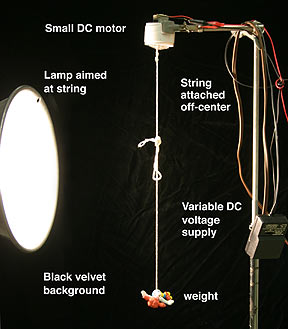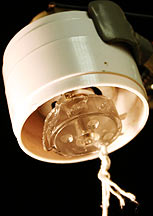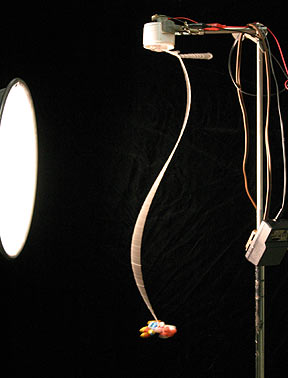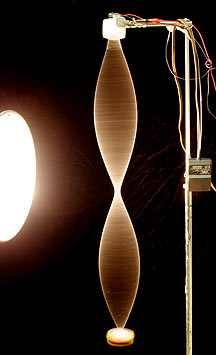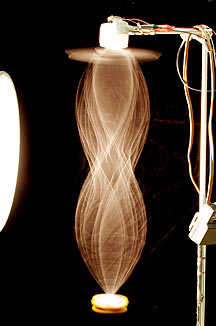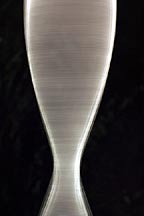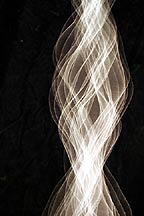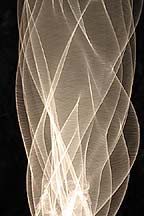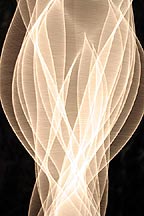|
Andrew Davidhazy
Some time ago I received an email message from an editor who had been exploring my website and who thought I might have some photographs that could be applicable to an article about a theory that has the world of science abuzz. It is the "String theory". I am not sure what this is all about but this person wanted to obtain photographs of vibrating strings or rubber bands or related items that could be used for this application. I decided to go out on a limb on this one and I replied that maybe a couple of photographs of mine of bullets breaking a series of tightly stretched rubber bands might be of interest. I added, however, that I had other photographs that were not on my website that were indeed pictures of strings but that I did not know where they were at that time. The truth was I had no photographs of strings in any shape or form but the inquiry started me thinking and I thought I previsualized what these images might look like and how they would be made. The fact I had a digital camera at my disposal made it possible to check out my ideas in short order. Since the request was for an image that would show strings moving in odd ways and vibrating this reminded me of strings in musical instruments where a taut string is held on both ends and plucked in the middle to produce sound waves. I also rememberd from somewhere, maybe a physics class, that one could also simply hold one end and make the other end move up and down. If done properly this would induce a wave-like motion on the string that under some conditions would be a "standing wave". This started me thinking about other ways to induce vibrations in a string and I built a set-up where the string was attached on one end to a fastener located on the edge of a rotating disc driven by a small electric motor whose speed could be varied by changing, with a theostat, the volatage driving the motor. I then attached a small weight to the other, free, end and let gravity pull the string down. When the motor was turned on the fact that the point of attachment was off center at the top provided the needed movement to make the string not only rotate but to start to vibrate. At some voltages a nice standing wave was produced while the string gyrated in regular fashion. I lined up the string against a black background and flooded it with light from a 300 watt floodlamp. I lined up my Canon Digital Rebel camera so that it was vertical and with the image plane parallel to the string. As the string rotated I made a few exposures using a shutter speed fast enough to catch the vibrating action of the string as a sharp record. The resulting images showed simply a string with a wave in it. Not too exciting I thought. Next I decided to go contrary to convention and instead of making a sharp record of the string I purposefully chose an exposure time long enough to allow the sting to make several rotations during the exposure cycle. This, now, revealed the rotating string not as a single line in space with a wave in it but rather as a "volume", something that seemed to have a 3-dimensional quality to it. This was a bit more interesting than the plain string picture but then something unexpected happened. While adjusting the voltage to the motor the voltage went so high as to cause the rotating string to assume a changing wave pattern as the weighted-down string could not keep up with the speed of the disk powering it. The string wrapped up onto itself pulling the weight upwards and causing the string to perform rather erratic motions in the process. I continued photographing and when these images were displayed on the LCD screen of the camera it became clear that as far as an interpretation of a vibrating string, that might accompany an article about the String Theory, these photographs seemed to hold much more promise than a simple image of a plain string with a wave pattern on it. The motor was turning the string at a rate of something like 2 to 10 revolutions per second. I had chosen an exposure time of 1/2 second so the string had a chance to rotate from once to 5 times during the time the shutter was open. With the camera set to manual exposure I used an EI of 100 and adjusted the aperture on the lens to provide sufficient exposure so that when I examined the histogram there seemed to be good highlight and good shadow detail.
The vibrating string appeared to have volume in the final photographs even though it was just a single string whirling in space. This was because the string delivered uneven amounts of exposure to the sensor depending on whether it was traveling towards or away from it or at a right angle to it during the rotation cycle. When moving at a right angle the exposure was as short as the time it took the string to travel a distance equal to its own width. When moving towards or away the string appeared to remain on the same spot on the sensor for a longer time. This created variations in exposure giving rise to exposure and thus brightness variations. In effect the moving string had become its own shutter! If the string made more than one turn then subsequent passes would superimpose on previous passes in an unpredictable cacophomy of sequential interactions. These manifested themselves visually once the images were recorded and were examined on the camera's LCD display or, later, on my computer. After making a about 50 or so photographs using this set-up I downloaded the images to my computer and selected the ones that in my opinion seemed to hold the most promise for application to an article about vibrating strings, the String Theory. Before the day was out I adjusted the cropping, levels and color balance and uploaded these to my website. I then notified the potential client of the fact that I had found my photographs of vibrating strings and that she could look at them on the web. Shortly thereafter I received a message stating that the editors indeed found the images interesting and that they wanted to include one of them as an illustration to go along with the article. One of my "found" vibrating string photographs ultimately made it to the pages of the August 2005 issue of Discover magazine and also onto the cover of an annual report right here at RIT. This turned out to be a fun little exercise and profitable too boot!.
|
